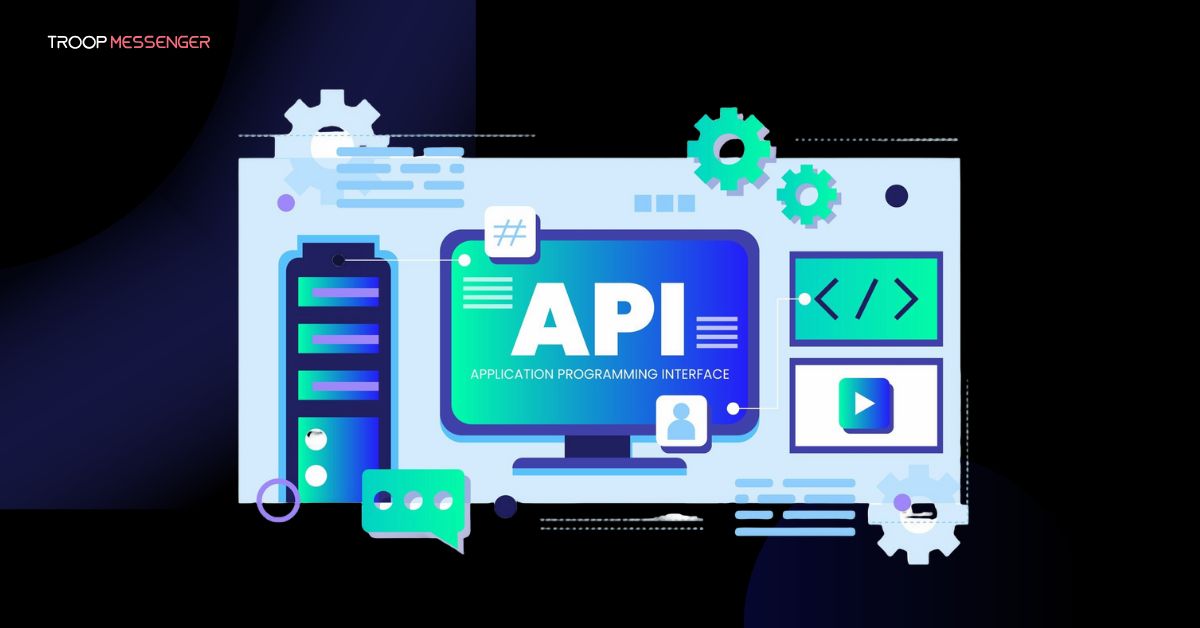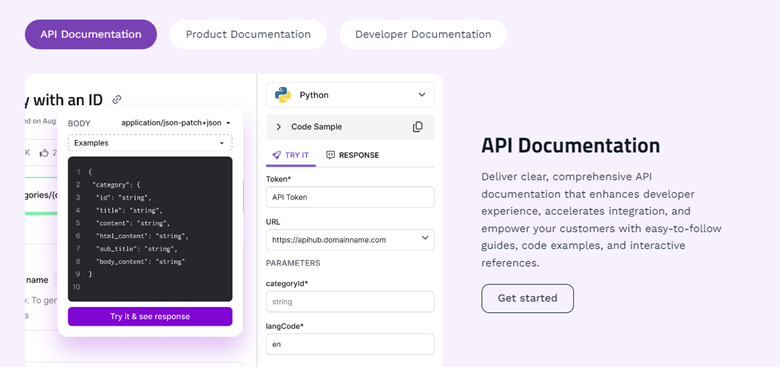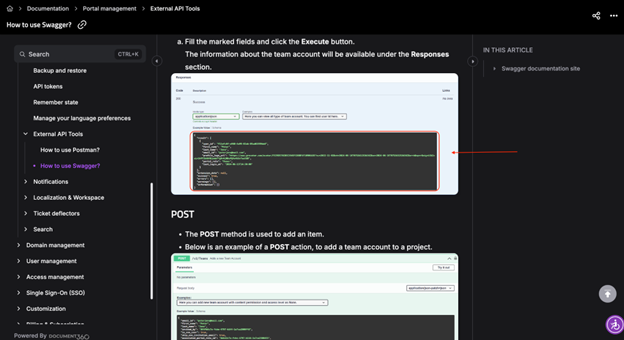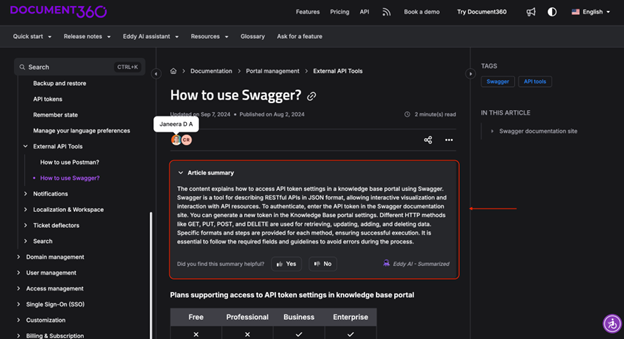Connect with us

Why Does API Documentation Matter in SaaS?
The SaaS landscape is growing, especially with the advent of AI integration.
Moreover, companies haven’t stopped upgrading their existing features and adding new APIs to enhance their capabilities.
But as SaaS businesses focus on making their interfaces look more sophisticated yet intuitive, developers often find themselves stuck with the complex challenges of product and API implementation.
This is why SaaS businesses must create API documentation to help clients overcome any questions regarding API integration.
With well-crafted API documentation, your business can bridge the knowledge gap between the product and developers. This results in:
- Simplification of intricate processes
- Earlier adoption of products and services
- Helping users harness the full potential of your product
That’s not all. API documentation can be a game-changer for your SaaS business as it reduces support queries and ensures complete customer satisfaction.
Before we see how to create API documentation, let’s first understand this concept.
What is API Documentation?
API documentation is a comprehensive guide that helps you understand and use the software's programming interface. It's a set of instructions that explains how your application can interact with a SaaS product's features and data.
Think of it as a manual that outlines available endpoints, request methods, parameters, and expected responses.
With good API documentation, your business can help users:
- Integrate services seamlessly
- Save time
- Reduce errors
API documentation typically includes code samples, authentication methods, and best practices.

So, whether you're building a new feature or troubleshooting an issue, well-crafted API documentation is your go-to resource for leveraging a SaaS platform's full capabilities.
4 Common Benefits of Having an API Documentation
Now that we know what API documentation is and how it works, it is time to reflect and see the benefits one can gain from its use. Our list of four benefits include:
1. Reduces user onboarding time and costs
Using well-structured API documentation helps your users understand and implement the API quickly while significantly reducing integration time. This means your clients can use the SaaS product faster, reducing project costs and accelerating their time to market.
2. Improves the developer experience
Clear, comprehensive documentation works like a roadmap for your customers, helping them navigate the API’s features and implementation process. With code samples and usage guidelines at your fingertips, your users will find development more enjoyable and less time-consuming.
3. Clear API specifications
Detailed specifications in the documentation help you understand exactly:
- What each endpoint does
- What parameters it accepts
- What responses to expect
This clarity prevents misunderstandings and allows your client’s developers to code confidently, reducing errors and debugging time. Well-defined specifications also outline:
- Data types
- Rate limits
- Error codes
This enables your clients to handle various scenarios effectively.
Understand that when you provide a clear contract between the API and your application, these specifications facilitate smoother integrations and help maintain consistency across different versions of the API too.
4. Reduce the need for customer support
With thorough documentation, your clients can often find answers to their questions regarding API use and integration without contacting your support. This self-service approach saves you time and allows you to allocate resources more efficiently, potentially leading to improved customer satisfaction and lower support costs for you.
7 Tried-and-Tested Tips to Write API Documentation Successfully
In this section, we aim to explore 7 crucial tips that will allow you to successfully write and manage your API documentation. Our list includes the following:
1. Offer users clear authentication guidelines
When creating API documentation, providing clear authentication guidelines is crucial. Start by explaining the authentication methods your API supports, such as API keys, OAuth, or JWT tokens. Walk users through the process of obtaining credentials and implementing them in their requests.
Best Practice: Include code snippets for different programming languages to demonstrate how to authenticate requests.

Explain any security best practices, such as not hardcoding API keys in source code and using environment variables instead. Remember to outline the scopes or permissions associated with different authentication levels, helping your clients understand what they can access with their credentials.
2. Break down instructions into numbered or itemized steps
Complex processes become more manageable when broken down into clear, sequential steps. When explaining how to use your API, use numbered lists for processes that must be followed in order and bullet points for related but non-sequential information collections.
Best practice: For each significant API operation, provide a step-by-step guide. For instance:
- Authenticate your request (add a button like - see authentication guidelines)
- Construct your API endpoint URL
- Set any required headers
- Send your request
- Parse the response
Using this approach, you help your clients follow along easily and reduce the chance of missing crucial steps, making API implementation simpler. Also, don't forget to include examples of what your clients should expect at each stage, such as sample request bodies or response outputs.
3. Provide a clear starting point for developers
Every developer approaching your API documentation needs a clear entry point. Begin your documentation with a "Getting Started" or "Quick Start" guide that helps users make their first successful API call as quickly as possible.
Best Practice: Create a simple, achievable goal for the user's first interaction with your API.
Tools like Document360 achieve so by using their feature called Eddy AI, which provides a quick summary like this:

Here, this summary helps their users understand:
- What is the API for
- How they can authenticate the API
- And how users will initially interact with the API
This approach gives your SaaS product users an immediate sense of accomplishment and encourages them to explore further.
4. Select the right documentation tool
Another crucial tip is to choose the right documentation tool for your business. In this case, selecting a tool that helps you create all forms of documentation in a single portal rather than creating multiple websites would be suitable. This way, you can enhance the developer experience at the client’s end and ensure that they find all relevant data in one place.
Best practice: Choose your API documentation tool based on the following criteria:
- Allows you to add code snippets in whichever format you prefer
- It helps you support powerful search and navigation options that help developers find relevant documentation articles faster
- Supports writing lengthy and informative articles that can be edited based on upgrades in your product
- Offers robust authoring tools that help you edit and publish your documentation seamlessly
- Provides multiple integration options with APIs to enhance the performance of the documentation and its performance
- Supports in-depth customization options that allow you to change the look and feel of your documentation as per your branding
- Supports the use of generative AI and helps your users get a quick summary of every documentation article in seconds
5. Include interactive examples
Interactive examples are a powerful way to help users understand and experiment with your API without leaving the documentation. They allow developers to see real requests and responses, boosting their confidence in using your API.
Best practice: Implement an embedded API console within your documentation.
This could be as simple as providing pre-filled cURL commands that users can copy and paste or as advanced as a fully interactive interface where users can input their parameters and see live results.
6. Standardize your API design
Consistency in your API design makes your documentation more straightforward to understand and your API easier to use. Adopt standard conventions for endpoint naming, request/response formats, and error handling across your entire API.
Best Practice: Follow REST principles where applicable, and document your conventions. For example:
- Use plural nouns for resource names (e.g., /users instead of /user)
- Use HTTP methods appropriately (GET for retrieval, POST for creation, etc.)
- Implement consistent error responses across all endpoints
Document these conventions in a dedicated section of your API documentation. This will help developers understand the logic behind your API design and make it easier for them to predict how unexplored parts of the API might work.
7. Review and update your documentation regularly
API documentation is not a "set it and forget it" task. As your API evolves, your documentation needs to keep pace. Outdated documentation can lead to frustration, errors, and increased support burden.
Best practice: Implement a regular review cycle for your API documentation.
This could involve the following:
- Automated tests that verify the accuracy of your documentation against your actual API responses
- A quarterly review process where team members go through the documentation and test all examples
- A system for users to report inaccuracies or suggest improvements to the documentation
A quick advice: Consider using a version control system for your documentation, just as you would for your code. This allows you to track changes over time and potentially offer documentation specific to different API versions.
Start Creating Your API Documentation Today!
Remember, your API documentation is often the first point of contact between your clients and your product.
By following these tips and continuously improving your documentation, you're explaining how to use your API and creating a positive, empowering experience for clients and their developers.
So, start building good API documentation that helps relieve client frustration and efficiently ease your product implementation.








